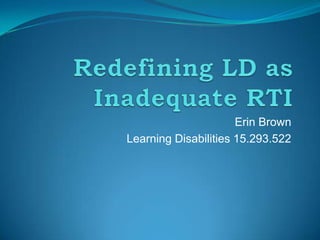
Rti presentation
- 1. Erin Brown Learning Disabilities 15.293.522
- 2. Overview of Reading Growth Concerns Latest Research Critique of Current Methods Development of RTI’s
- 3. •SLD is the #1 disability within the Special Education Population •LD students grew from 1.2 million to 2.8 million in less than 20 years •50% of Special Education students are classified LD •That’s 5% of the school age population!
- 4. Growth Concerns Explanations for Growth The Concern More socially accepted More expensive to term educate Identification of the Special Ed.=$12,000 academic and social Regular Ed.=$6,500 problems linked to LD Cost fuels research and Real world literacy change demands
- 5. Focuses on IQ achievement discrepancy method Points out the false assumptions made by using the IQ discrepancy method
- 6. Latest Research: RTI’s 1982 National Research Council (Heller, Holtzman and Messick) developed criteria for the validity of Special Education Classification First two focus on “instructional quality” Third focuses on the assessment process
- 7. L.S. Fuchs Framework • Rate of growth for all students is tracked Phase I • Purpose is to determine if the overall rate of responsiveness is the Reg.Ed. Setting is adequate • Assessment for individuals who demonstrate low performance Phase II compared to classroom peers • Purpose is to identify a “subset of children at risk” • Classroom modifications in place; use systematic testing to investigate individual response Phase III • Purpose is to determine if the Reg.Ed setting can be modified to become a productive learning environment for an at-risk student
- 8. L.S.Fuchs Framework Had an additional 4th Phase but was later dropped from the Identification model Relies heavily on the use of Curriculum Based Measurement
- 9. CBM demonstrated in Framework Phase I: evaluated classroom instructional quality Phase II: “Risk” was defined by dual discrepancy (CBM level and CBM rate of growth) between students and peers Phase III: CBM index the responsiveness: The goal was to increase the CBM levels and rate to within the majority of peers
- 10. RTI’s support LD Initiative ( Sponsored by the US Department of Education’s Office of Special Education) President’s Commission on Excellence in Special Education National Academy of Sciences
- 11. The Promise of RTI's Dismisses the “wait to fail” model • Significantly reduces late identification • Reduces teacher referral by observation Closes the gap between identification and intervention • Assessment measures drives instructional planning and implementation Identification based on risk rather than deficit model • Will benefit all students including those without LD • Screened for problems in both academic and behavioral domains • Provides a better mix of services between Reg.Ed and Spec.Ed.
- 12. Promise cont’d Uses CBM • Replicates academic growth • Can distinguish between ineffective teaching and unacceptable performance Identification as early as Kindergarten • Won’t slip through the radar • Can produces some false positives but all students still benefit Reduction of Identification Bias • Reduced “teacher-referral” process • Reduces the variability between states and local agencies Strong Focus on Student Outcomes • Connects identification assessment with instruction • Ongoing • Effective core academic instruction
- 13. The Pitfalls of RTI’s Is LD Real? Do we have validated intervention models and measures to assures instruction validity? Is RTI the final step before classification? How intensive should instruction be in all phases? How do we train our teachers? When is the process of RTI really over?
- 14. Pitfalls Is LD Real? Do we have Is this the final How intensive Are there When is the • Definition of a validated step in should enough trained process over? disability methods? identification? instruction be? teachers? • If due process is • Assumed to be • Tools in some • If a student fails in • How do we • Teachers need a too early, then it permanent areas but not all the “at risk” determine the variety of can disrupt the • RTI’s manipulate • More focus on environment is duration and knowledge and process and the environment primary grades he/she intensity of a skill in prolong the disproving any then older grades automatically program? administering identification presence of deemed LD? assessments, process • Focus on reading cognitive/ • LD comorbid with interpreting the • Too early can neurological other disorders: results and save a student deficits What eliminates developing the from the presence of most effective Reg.Ed/Spec.Ed. other factors program for limbo contributing to the success for disability? students
- 15. Real Life Examples and Resources • Pre-Referral Intervention Manual (PRIM)-Third Edition Stephen B. McCarney,Ed.D., Kathy Cummins Wunderlich, M.Ed., Edited by Samm N. House • PRIM contains over 4,000 intervention strategies for the 219 most common learning and behavior problems.
- 16. Examples Currently used Documentation Methods in NJ I&RS NJ I&RS: http://www.nj.gov/education/students/irs/ for manual
- 17. Fuchs, L.S., & Vaughn, Sharon. (2003). Redefining Learning Disabilities as Inadequate Response to Instruction: the Promise and Pitfalls. Learning Disabilities Research and Practice.18(3),137-146.